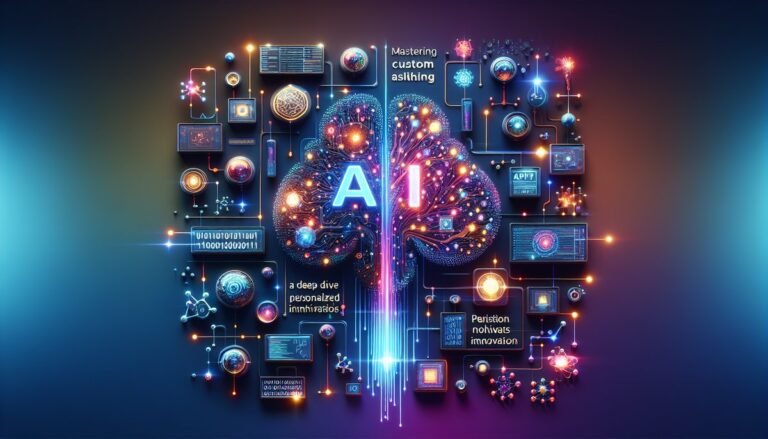In an era where technological advancements continually reshape the landscape, AI-Designed CPUs are emerging as a groundbreaking force set to transform not just computing, but the entire fabric of modern technology. These innovative processors are crafted with the precision of artificial intelligence, promising to usher in a new age of efficiency and capability that was previously unimaginable. Imagine a world where your devices anticipate your needs before you even realize them, or where data processing speeds leap beyond today’s limits—all thanks to these AI-driven powerhouses. As we stand on the brink of this technological revolution, the potential applications and benefits of AI-Designed CPUs are as vast as they are exciting. Dive into our exploration of seven compelling reasons why these CPUs are poised to redefine what’s possible in the tech world.
1. The Innovative Leap of AI-Designed CPUs
AI-Designed CPUs represent a groundbreaking shift in how processors are conceptualized and built. Unlike traditional methods where human engineers meticulously plan each aspect, Artificial Intelligence takes the helm, offering fresh and unconventional designs that challenge the status quo. These AI-driven designs can optimize for performance, energy efficiency, and cost in ways that human engineers might not conceive.
This innovation is akin to having a digital architect who continuously learns and adapts from a vast array of design scenarios. AI-Designed CPUs can potentially revolutionize multiple industries by bringing more efficient processing power to computers, smartphones, and even specialized hardware like autonomous vehicles and IoT devices. The practical implications of this are immense, suggesting a future where devices are more powerful yet consume less energy.
2. Speeding Up the Design Process
One of the most significant advantages of AI-Designed CPUs is the acceleration of the design process. Typically, CPU development is a labor-intensive task that can take years of effort from skilled engineers. By incorporating AI, the design timeline shrinks dramatically, allowing for rapid iterations and improvements.
Imagine a world where the time from concept to market is cut in half or even more. This rapid development cycle not only saves time but also reduces costs and resources. This efficiency could lead to more frequent releases of new, cutting-edge processors, keeping up with the ever-increasing demands of modern technology and consumer needs.
3. Enhanced Performance and Efficiency
AI-Designed CPUs are not just faster to create; they also offer enhanced performance and efficiency. By leveraging AI algorithms, these processors can be tuned to perfection, balancing power consumption with processing speed more effectively than ever before. This is particularly crucial in an era where green technology and energy efficiency are paramount.
The potential for AI to design CPUs that run cooler and consume less power can extend the battery life of portable devices and reduce energy costs for data centers. For instance, imagine data centers that can serve millions of users while significantly minimizing their carbon footprint—this is the kind of transformation AI-Designed CPUs can bring about.
4. Customization for Specific Applications
Another compelling aspect of AI-Designed CPUs is their ability to tailor designs to specific applications. Rather than a one-size-fits-all approach, AI allows for the creation of processors that are bespoke for particular tasks. This customization means that specialized hardware can be developed for niches like machine learning, gaming, or even quantum computing.
Such tailored designs ensure that each CPU is optimized for its intended use, leading to unparalleled performance in its domain. Whether it’s rendering high-definition graphics or crunching complex data sets, AI’s capability to tailor CPU designs is a game-changer for industries seeking specialized solutions.
5. Paving the Way for Future Innovation
The advent of AI-Designed CPUs opens the door to future innovations that were previously thought impossible. As AI continues to evolve, so too will the complexity and capability of the CPUs it designs. This means that future iterations will not only be more powerful but also potentially integrate new technologies that haven’t even been conceived yet.
This forward-thinking approach ensures that as new technological challenges arise, AI-Designed CPUs will be at the forefront of meeting those needs, fostering innovation across computing, robotics, and beyond. This capability to continuously adapt and advance is what makes AI-Designed CPUs a pivotal development in tech evolution.
6. Democratizing CPU Design
AI-Designed CPUs could significantly democratize the field of processor design. Traditionally, designing a CPU required access to expensive resources and a high level of expertise. AI lowers these barriers, enabling more players to enter the field, from small startups to educational institutions.
This democratization could lead to a surge in innovation as diverse perspectives and ideas are brought to the table. We could see an increase in niche processors tailored to specific markets or applications, broadening the scope of what is possible in CPU technology and making cutting-edge designs accessible to a wider audience.
7. Enhancing Security and Reliability
Security and reliability are critical concerns in CPU design, and AI-Designed CPUs can enhance these aspects significantly. AI can analyze vast amounts of data to predict and mitigate potential vulnerabilities, ensuring that processors are robust against a wide range of threats.
In a world where cyber threats are constantly evolving, having CPUs that are inherently more secure is a considerable advantage. This enhanced security not only protects sensitive data but also ensures that systems remain reliable and stable, reducing the risk of failures that can have costly repercussions. With AI-Designed CPUs, the future of secure and reliable computing is promising and within reach.
AI’s Transformative Path in CPU Design and Beyond
AI’s role in designing a CPU marks a remarkable milestone in technological innovation, setting the stage for unprecedented advancements. This achievement underscores AI’s potential to revolutionize hardware development, enhancing both performance and efficiency. As AI continues to break barriers, its integration into fields traditionally dominated by human expertise encourages us to rethink the possibilities. The melding of AI with CPU design not only predicts a future of faster, more efficient processors but also invites a broader exploration of AI’s capabilities across diverse sectors. As we venture into this new era, the key takeaway is clear: embracing AI’s potential can lead to breakthroughs that transcend conventional technological boundaries, paving the way for a future rich with innovation and opportunity.






